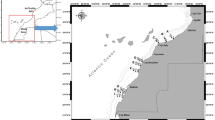Abstract
The aim of the study was to quantify heavy metal (mercury, lead, cadmium, and arsenic) concentration in tissues (muscles, liver, kidney, gills, and gonads) of six fish species (carp: Cyprinus carpio, tench: Tinca tinca, pumpkinseed: Lepomis gibosus, prussian carp: Carassius auratus gibelio, hasselquist: Salmo dentex, eel: Anguilla anguilla) from the freshwaters of the Nature Park Hutovo Blato, Bosnia and Herzegovina, and determine whether they are potentially harmful for human health if included in the diet. Fish were angled from the Svitava Lake in the second part of August of the year 2003, and fish tissues were stored at −18°C until analysis. Heavy metal concentration was determined by atomic absorption spectrophotometry in the Veterinary Institute Brno, Czech Republic, and expressed as mg·kg−1 of wet tissue. Concentration of mercury, lead, and arsenic in most tissues of all analyzed fish types is lower than the maximal allowed concentration (MAC) in most countries. Cadmium concentration is also low in muscles and gonads, but kidney, liver, and gill concentrations exceed MAC value in most countries. Hasselquist, an endemic type for that region, differs from other fish types in the fact that it has very low cadmium concentration in liver and kidney, but the highest concentration of arsenic in most tissues, especially muscles. In muscles and gonads of all fish types analyzed, Pb is present in higher concentration than Cd, whereas in liver, gills, and particularly kidney, the situation is opposite, suggesting diverse metabolic pathways and unequal bioaccumulation of these two metals in different fish tissues. Although the region of the Nature Park Hutovo Blato in Bosnia and Herzegovina is not an agricultural territory, the intensive agricultural activities in the neighboring regions already result in high cadmium concentration in inner organs of fish species analyzed. Therefore, fish types in the freshwaters of the Park may be included in the human diet, but without inner organs and gills (or the whole head).


Similar content being viewed by others
References
Barak NAE, Mason CF (1990) Mercury, cadmium and lead concentrations in five fish species of freshwater fish from eastern England. Sci Total Environ 92:257–263
Bogut I (1997) Water pollution by heavy metals and their impact on fish and human health. Hrvatske Vode 5:223–229
Bogut I, Has-Schon E, Janson R, Antunović Z, Bodakoš D (2000) Concentrations of Pb, Hg, Cd, and As in meat of fish-pond carp (Cyprinus carpio). Papers of 8th International Symposium Animal Science Days, Osijek: 123–125
Bogut I, Novoselić D (2005) Sistematika riba. In: Ribarstvo 1—Anatomija i fiziologija riba, sistematika riba, ekologija i zaštita riba, University of Osijek and Mostar, Grude, 179–403
Bošnir J, Puntarić D, Šmit Z, Capuder Ž (1999) Fish as an indicator of eco-system contamination with mercury. Croat Med J 40:546–549
Collings SE, Johnson MS, Leah RT (1996) Metal contamination of angler-caught fish from the Mersey Estuary. Mar Environ Res 41:281–297
Doganoc D (1995) Ostanki Pb, Cd, As in Hg v slatkovodnih in morskih ribah z območja Slovenije. Papers of the Scientific Meeting ‘‘Toxic Substances in Food and Object in Common Use,” pp 119–127
Glantz SA (1997) How to test for differences between groups. In: Primer of biostatistics, 4th ed. McGraw-Hill, New York, pp 32–64
Harada M (1995) Minamata disease: methylmercury poisoning in Japan caused by environmental pollution. Crit Rev Toxicol 25:1–24
Has-Schön E, Bogut I, Strelec I (2006) Heavy metal profile in five fish species included in human diet, domiciled in the end flow of River Neretva (Croatia). Arch Environ Contam Toxicol 50:545–551
Holčík J, Hensel K (1972) Handbook of ichthyology [in Slovak]. Obzor, Bratislava, Slovakia, p 217
Horvat D, Ivezić M (2005) Analiza varijance. In: Biometrika u poljoprivredi, Poljoprivredni fakultet. Osijek, Croatia, pp 192–193
Kudo A, Miyahara S (1984) Mercury dispersion from Minamata Bay to the Yatsushiro Sea during 1975–1980. EcotoxicoI Environ Saf 8:507–510
Máchová J, Svobodová Z, Hrjtmánek M, Hrbková M (1991) Control of hygienic quality of fish from the point of view of foreign substances content. In: Vykusová B (ed) Diagnostic, prevention and therapy of fish diseases and intoxications. Manual. Vodnany, Czech Republic, pp 325–445
Martinović Đ, Koštrun M, Čaušić N (1994) Koncentracija teških metala u tkivima šarana. Papers of the Scientific Meeting “Metal in Food and Environment”, Stubičke toplice, pp 247–252
Ministry of Health 1, Republic of Croatia (1994) By-law on the allowed concentrations of pesticides, toxins, myco-toxins, metals, and histamine and related substances in food, and on other safety conditions of food and necessities in large-scale use. Narodne novine no. 46, p 30
Ministry of Health 2, Republic of Croatia (2001) By-law on modifications and amendments of the by-law on the allowed concentrations of pesticides, toxins, mycotoxins, metals, and histamine and related substances in food, and on other safety conditions of food and necessities in large-scale use. Narodne novine, no. 11, p 31
Pourang N, Nikouyan A, Dennis JH (2005) Trace element concentrations in fish, surficial sediments and water from northern part of the Persian Gulf. Envir Monit Assess 109:293–316
Svobodova Z, Vykusova B, Machova J, Hrbkova M, Svobodnik J (1993) Monitoring of foreign substances in fishes from the Elbe river in the Ćelakovice locality. Bull VURH Vodnany 29:47–61
Tsubaki TK (1977) Minamata disease: methyl mercury poisoning in Minamata and Niigata, Japan. Elsevier Scientific, Amsterdam
Wayne WD (2005) Analysis of variance. In: Biostatistics, 8th ed. Hoboken, New Jersey, John Wiley & Sons, pp 303–320
WEB 1: http://www.portfolio.mvm.ed.ac.uk/studentwebs/session2/group29/introtox.htm Accessed: April 16, 2007
WHO/FAO (1985) Joint FAO/WHO standards programme. Codex committee on food additives. Information on legal and other administrative limits for contaminants in food. Hague, WHO
Author information
Authors and Affiliations
Corresponding author
Rights and permissions
About this article
Cite this article
Has-Schön, E., Bogut, I., Rajković, V. et al. Heavy Metal Distribution in Tissues of Six Fish Species Included in Human Diet, Inhabiting Freshwaters of the Nature Park “Hutovo Blato” (Bosnia and Herzegovina). Arch Environ Contam Toxicol 54, 75–83 (2008). https://doi.org/10.1007/s00244-007-9008-2
Received:
Accepted:
Published:
Issue Date:
DOI: https://doi.org/10.1007/s00244-007-9008-2




